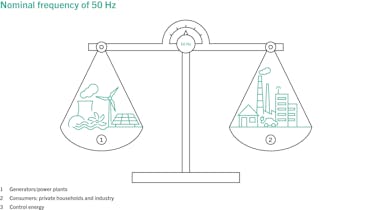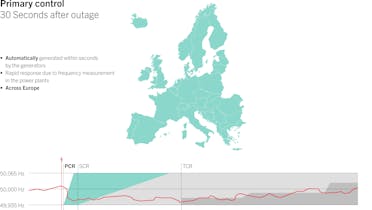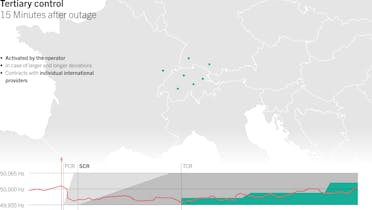
What do our health, work and finances have in common with the extra-high-voltage grid? The need for balanced management in order to benefit. In the Swissgrid grid, this balance is achieved by maintaining a constant grid frequency of 50 hertz. If consumption is lower than generation, the frequency rises; if consumption is higher than generation, the frequency decreases.
To ensure that this frequency remains stable and that the extra-high-voltage grid operates smoothly, the balance between electricity generation and consumption must be guaranteed in real time. Swissgrid takes care of this 24 hours a day. Grid security and stability depend partly on this balancing.
Variations are normal
Fluctuations between generation and consumption are part of everyday life. Weather conditions can increase or reduce demand, for instance. All it takes is for one unforecast thunderstorm to darken the sky, and lights will be switched on everywhere, prompting an unexpected rise in the electricity consumption of an entire region. Business activities also play an important role: if there is a public holiday, the electricity consumption of companies will fall.
In addition, an unexpectedly sunny day will cause solar panel generation to soar, even if this had not been predicted in the forecasts. Or a day of unanticipated heavy rain, and hydroelectric plants will generate more electricity than planned.
All it takes is for one unforecast storm, and consumption in an entire region will rise unexpectedly.
A power plant outage is another potential scenario. Swissgrid is then forced to ask other electricity generation units to increase their output in order to restore the balance and maintain the grid frequency at 50 hertz.
Swissgrid therefore monitors its grid 24/7 from its two grid control rooms in Aarau and Prilly. The grid control rooms are the heart of the Swiss distribution grid. If unforeseen fluctuations occur, the control room operators take action. They decide whether more energy needs to be injected into or withdrawn from the grid to restore the balance so that the grid frequency will return to its set value of 50 hertz. To do so, the operators use control energy. This is described as «positive» when it involves injecting more energy into the grid and as «negative» when it involves reducing the volume of energy.
One, two, three..
Swissgrid has three types of control energy for managing fluctuations between electricity generation and consumption. Control energy is simply a reserve that the power plants keep available for Swissgrid, who can request it at short notice. Swissgrid buys this control energy in advance by tender. The cost of purchasing control energy is passed on to consumers via Swissgrid’s tariffs. The three types of control energy have different speeds of activation.
- Primary control energy is automatically activated thirty seconds after the detection of a frequency deviation. It is taken directly from the output of the power plants. The power plants are configured to respond automatically and without delay to any changes in grid frequency. Depending on consumption, they automatically increase or reduce their power. This system works like cruise control in a car.
- Secondary control energy takes over after five minutes. Activation of this energy is also automatic. The power is supplied by the power plants in response to an automatic signal sent by Swissgrid.
- Tertiary control energy is activated manually by the operators of Swissgrid’s grid control rooms after fifteen minutes. This energy is activated in the event of longer deviations. If necessary, it can then be supplemented by fixed contracts with energy suppliers.
Careful planning to ensure harmony
In order to maintain the extra-high-voltage grid at a constant frequency of 50 hertz, Swissgrid works closely with power plants and electricity traders to plan ahead. Traders are obliged to always inject the same volume of energy into the grid, i.e. by generating or purchasing electricity, as they sell. They therefore send Swissgrid’s grid control rooms provisional electricity generation/purchase and sales schedules, which are rigorously checked by the Swissgrid operators. The aim is to ensure that the sum of all the commercial transactions carried out by power plants and electricity traders is balanced. These provisional schedules may still need to be adjusted shortly before and even during operation to ensure the balance of the transmission grid.
Balance is the result of meticulous, coordinated teamwork.
Additional information
The Swiss transmission grid is not the only one to operate at 50 hertz; the entire interconnected European grid does so too. Swissgrid works with other transmission system operators to ensure that the frequency of this interconnected grid can be maintained at all times.










